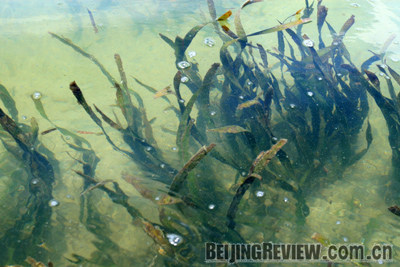|

VALUABLE GRASS: Seagrass, a shallow saltwater plant that can flower underwater and is
found in temperate and tropical ecosystems, is valuable for its sensitivity to environmental changes
China has set up its first-ever seagrass-monitoring station in southern Guangxi Zhuang Autonomous Region, which will be part of a global network.
The station was co-sponsored by the Guangxi Mangrove Research Center and the Seagrass Monitoring Network of the World Seagrass Association. The latter provides the station with internationally standardized monitoring equipment. Findings from the station could help better protect seagrass and their beds.
Seagrass, which is a shallow saltwater plant that can flower underwater and is found in temperate and tropical ecosystems, is valuable for its sensitivity to environmental changes. The marine plant requires a high light environment, meaning it can reflect harmful changes in the oceans. There are 60 species of such grass in the world.
Scientists have found that seagrass systems are important in providing habitats and food for other marine life and for keeping the water clean. Seagrass beds also help stabilize sediment, and hamper waves and currents. Binding sediments protects coral reefs, and the dampening of storms can help protect human settlements. It is also thought that seagrass could help as a buffer against the impacts of climate change acidification on coral reefs.
The Beibuwan Gulf off Guangxi's Beihai City boasts eight species of seagrass. The UN Environment Program built eight seagrass meadows covering about 540 hectares in the region last year, in a scheme aimed at reversing environmental degradation in the South China Sea and the Gulf of Thailand.
|
The World Seagrass Association is a global network of scientists and coastal managers committed to research, protection and management of the world's seagrass. The idea of the association has its genesis in a keynote address by Professor Ronald Phillips at the Third International Seagrass Biology Workshop in 1998.
Its members come from many countries and include leading scientists in marine and seagrass biology. The association supports training and information exchange and raises global awareness of seagrass science and environmental management issues. | | 